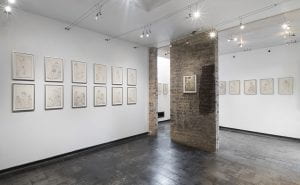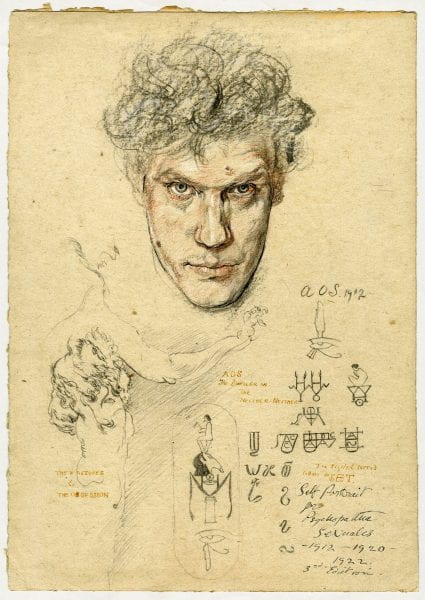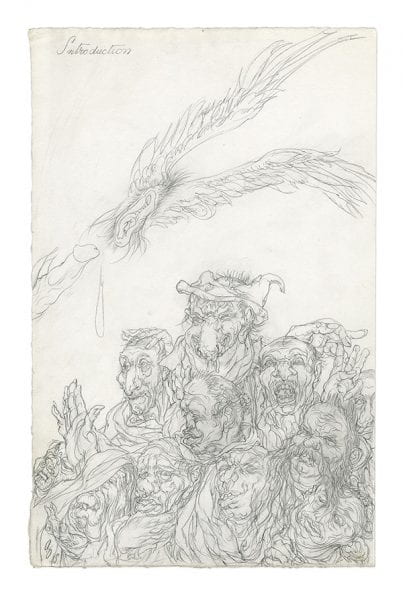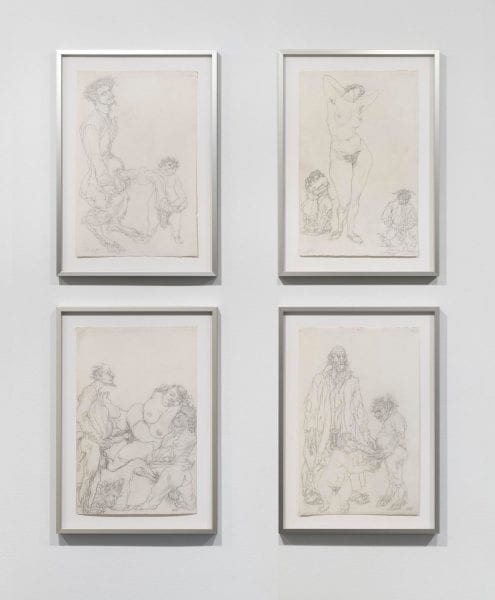 This spring, the Kinsey Institute is partnering with Iceberg Projects in Chicago to present the first exhibition of a rare folio of erotic drawings by English artist Austin Osman Spare titled Psychopathia Sexualis.
This spring, the Kinsey Institute is partnering with Iceberg Projects in Chicago to present the first exhibition of a rare folio of erotic drawings by English artist Austin Osman Spare titled Psychopathia Sexualis.

The Artist
Austin Osman Spare (1886–1956) was an English artist and writer, lauded by his peers as one of the finest draftsmen of his generation. Exhibitions of his pen and ink drawings of grotesque subjects and themes during the early years of the twentieth-century drew comparisons to the work of Aubrey Beardsley and Albrecht Durer, and he seemed poised to establish himself as one of England’s great new artistic talents until the intervention of World War I. Demand for his work lagged in post-war culture, and his career faltered for a decade and a half. Interest in his work revived in the late 1930s when tastes changed again, and Spare continued to produce work and exhibit until his death in 1956.
One of the practices that Spare participated in was automatic drawing, which was popularized by artists in the surrealist movement. Spare started creating what he called “psychic” and later “automatic” drawings in 1914, and this process was an exploration of the subconscious, in which he put himself into a trance and started drawing, with no pre-conceived notion of what would end up on the page. This became a central feature of Spare’s practice and foregrounds the folio on display at Iceberg Projects. These drawings started off as automatic and then Spare refined them, adding detail and depth, and creating the wild and abject scenes in these drawings.

The Artwork
They are not erotic or obscene drawings in the ordinary sense at all…
-Eric Dingwall
The drawings in the Psycopathia Sexualis depict monstrous figures, satyroi, and animals in couples and bacchanalian tableaus, along with self-portraits by Austin Osman Spare, all executed in Spare’s distinctive sharp graphite line work.
The title of the Kinsey Institute’s folio, Psycopathia Sexualis, is found on three of the works within it, drawing their name from the famous book written by early sexologist Richard von Krafft-Ebing. The principal drawings in the Psychopathia Sexualis most likely date from 1921–1922, and are similar to content in Spare’s later works The Book of Ugly Ecstasy and The Valley of Fear, suggesting that the Kinsey Institute’s folio is the first in a series. Spare himself referred to the contents of the folio throughout his life beginning in the late 1920s, making its discovery an important new primary source for scholarship on the artist.
Due to the erotic nature of their content, the drawings were illegal to possess and display when Spare created them and they were never published during Spare’s lifetime, but found safekeeping within the Kinsey Institute’s collection in 1963.
“That this folio survives is a testament to the care and support of the Kinsey Institute Collections staff. Our collections are comprised of every type of material you can imagine, and attests to the diversity of human sexual experience and expression. Every single item represents a different and unique story, one that the Kinsey Institute Library and Special Collections is honored to be able to preserve and protect, and Spare’s folio is no exception.” ~ Kinsey Institute Curator Rebecca Fasman
The Exhibition and Publication

Austin Osman Spare –Psychopathia Sexualis is the first exhibition of Spare’s work in North America, and the first time these works have been available to the public. The exhibition will be on display March 19 – May 22, 2022, at Iceberg Projects in Chicago, and features all forty-four drawings from the Kinsey Institute’s folio.
Coinciding with the exhibition, Fulgur Press has produced a full-color facsimile of the portfolio of Austin Osman Spare drawings from the Kinsey Institute, due for publication on April 30th, 2022. In addition to the forty-four works by Spare, the book will include texts by Robert Shehu-Ansell, Dr. Jeremy Biles, and Elijah Burgher that explore aspects of the artist’s work through both poetic and critical methods, as well as a Preface by Kinsey Institute Curator Rebecca Fasman, and an Introduction by Ryan Pfeiffer and Rebecca Walz.
The exhibition and publication are part of the Kinsey Institute’s 75th Anniversary celebration, and the 30th anniversary of the founding of Fulgur Press.